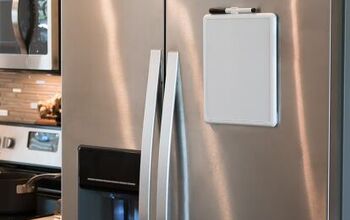How Long Should A Refrigerator Last? (Find Out Now!)

Buying appliances is expensive When it comes to large appliances like refrigerators and stoves, you are typically going to be spending more than a thousand dollars. So, you want to make sure you are getting your money’s worth when you do have to get something like that.
The typical refrigerator lasts about 10 to 13 years. However, some can last up to 20 years or more. The trick to a longer-lasting fridge life is maintenance. Clean the condenser coils, regularly, keep the vents clear, and lubricate the door gaskets and your refrigerator will have a longer life.
Do You Need Appliance Repair Services?
Get free, zero-commitment quotes from pro contractors near you.

The Four Essential Parts of a Refrigerator
There are four essential parts of your refrigerator that you have to worry about. The thermostatic expansion valve, evaporator, compressor, and condenser. Each one of these has its own important function that keeps your fridge cold and your food fresh.
Thermostatic Expansion Valve
The thermostatic expansion valve located at the end of the liquid line controls the amount of the refrigerant that flows into the evaporator.
Evaporator
The evaporator vaporizes the refrigerant and removes the heat from the inside of the refrigerator. This part reads and adjusts the pressure and temperature of the condensed liquid. It then separates the low pressure and high-pressure sides of the air conditioning system.
Compressor
By drawing the low pressure and low-temperature vapor from the evaporator, the compressor absorbs the vapor and increases the pressure, which results in a higher temperature. The hot gas is sent to the condenser to be released.
Condenser
This part is what turns the refrigerant steam into a liquid. During the condensation process, the heat from the refrigerant steam is cooled with a cooling medium, which can be classed into one of four types:
- The evaporation type uses the cold that is produced by the evaporation in another system to cool the steam. This transfers the heat and condenses the steam, turning into a liquid.
- The water and air cooling type uses water and air to cool the surface of the heat transfer tube. This forces the latent heat from the side of the refrigerant into water vaporization. The air speeds up the condensation and evaporation.
- The air cooling type cools the refrigerant with air. The air is either from fans or natural convection. These are freon-style refrigerators used in areas with a limited supply of water.
- The water cooling type cools everything with water. The water may be used once or reused and recycled. This is the most common type of condenser.
If any of these parts fail, you are going to notice right away that things are heating up in there instead of cooling down as they should. The ice cream melts, meats thaw, and the milk spoils. To prevent this from happening too soon, it is best to be proactive. Take care of the fridge and make sure to call a professional if you suspect a problem.
The Lifespan of Appliances
The refrigerator is the hardest working appliance in the house. After all, it has to work 24 hours a day, seven days a week no matter whether it is hot or cold outside. It runs constantly, keeping your ice cubes frozen and your produce from going bad. But they are not the first ones to give out.
The appliances with the lowest lifespan include the microwave, dishwasher, and compactor. They only last about six to nine years on average. The stove usually lasts the longest at about 13 to 15 years. Of course, this is just an average, not a guarantee. Some brands last longer than others.
5 Ways To Extend the Life of Your Refrigerator
The experts say that cleaning your refrigerator, inside and out, vacuuming the condenser coils, and maintaining the gaskets in the door will extend the life of your fridge. We are going to help you do that by explaining how to take care of your fridge.
1. Cleaning the Refrigerator
At least once a year, you need to give your refrigerator a good cleaning. Take everything out, clean all the shelves and walls, dump out the drawers, and wipe out the inside of the doors. Remove and clean the drawers if they need it.
You should also clean underneath the drawers whether you think they need it or not. Sometimes, spills make it down there and you don’t even know it. There should also be a drain hole there. Check to see that it is clear so it can drain.
In addition, check the drip pan under the fridge at this time. If it is full, empty it and give it a good cleaning. Make sure the door is sealing properly and be sure to check that the seal is not coming apart or drying out.
Important tip: Some new models do not have a drip pan or tray that you can access. If not, do not worry about it or, if it is leaking, call a professional.
2. Vacuuming the Coils
There are condenser coils on the back of your refrigerator, which are metal tubes coming from the compressor. These coils are what help liquefy the vaporized refrigerant to release the hot air from the fridge. A lot of dirt and dust can get trapped and caked around these coils.
This will prevent the heat from escaping and cause the fridge to work overtime. In fact, this is one of the easiest ways to keep your refrigerator from breaking down. Eventually, the heat will not be able to escape and your fridge will stop working. Vacuuming and cleaning the dust off the coils can prevent this from happening.
Important tip: Sometimes the tubes are at the base of the refrigerator behind the kickplate instead of behind it.
3. Lubricating the Door Gaskets
You may have never even noticed the rubber insulation around the edge of the inside of your refrigerator and freezer doors. But these are important parts of the fridge because they keep the cool air in and the hot air out. If you do not clean and lubricate them once a year, they can dry out and crack.
To clean and lubricate the gaskets, just open the door and clean them with a clean cloth and dry with a different clean cloth. Then apply petroleum jelly to the edges of the gaskets. Make sure you go all the way around the door. You may have to get up on a stool to get to the top, but you need to get that part too. Don’t forget the freezer!
4. Clear the Vents
Inside the fridge and freezer, there should be small vents found on the sides of your refrigerator as well as on the roof of your freezer. These vents need to be unobstructed to circulate the air. If you have food or anything else blocking these vents, this can cause uneven cooling, frost, or moisture build-up. Keep them clear and clean at all times.
5. Get Organized
Another good tip is to organize what is in your refrigerator and freezer so you can find things easier. The purpose of this is to reduce the amount of time the refrigerator door is open. It can also help you make fewer trips to the fridge. The less the door is open, the better.
Related Questions
What Are Some Signs That I Need A New Refrigerator?
There are the obvious reasons of course, like melted ice, warm beer, and spoiled milk. But there are also many subtle symptoms of an impending breakdown such as:
- If the outside of the fridge is hotter than usual, the motor is running hot. This is a sign that there is something wrong.
- There is a lot more condensation than usual. This can be a sign that your gaskets are bad.
- It is kicking on more often. Cycling on and off more frequently is a sign that the motor may be failing.
- Your electric bill is going up, but you are not running the air conditioner or other electronics more.
- When your food is spoiling faster than it should, this is a huge sign that it is time for a new fridge.
The United States Department of Health has a food chart that tells you how long certain things should stay good for. If your food is not lasting as long as what this chart says, you may need a new fridge.
| Food | Refrigerator | Freezer |
| Lunchmeat (unopen) | 14 days | 1 to 2 months |
| Bacon | 7 days | 1 month |
| Hamburger | 1 to 2 days | 3 to 4 months |
| Steaks | 3 to 5 days | 4 to 12 months |
| Ham (uncooked and uncured) | 3 to 5 days | 6 months |
| Ham (cooked) | 7 days | 1 to 2 months |
| Chicken | 1 to 2 days | 1 year |
| Eggs (uncooked) | 3 to 5 weeks | Do not freeze |
| Eggs (hard-cooked) | 7 days | Do not freeze |
| Leftover cooked meat | 3 to 4 days | 2 to 6 months |
| Leftover pizza | 3 to 4 days | 1 to 2 months |
Do You Need Appliance Repair Services?
Get free, zero-commitment quotes from pro contractors near you.

If your fridge has a water filter built-in, you should change it every three to six months, depending on the manufacturer’s instructions. This will help make sure your drinking water and ice stay clean and safe. It will also keep your water dispenser free of buildup, especially if you have hard water.

I am a DIYer who loves writing about anything home-related. When I am not writing, you can find me studying for my PhD in Psychology, photographing nature, and swimming at the lake with my grandkids.
More by Patricia Oelze



























